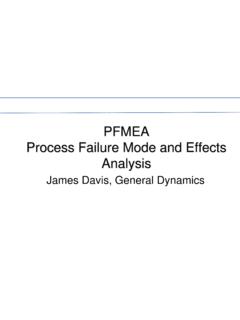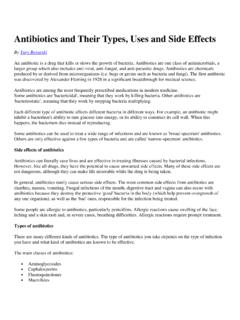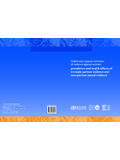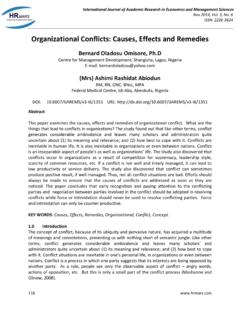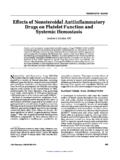Transcription of BEYOND BATTERING: Long-Term Effects of …
1 BEYOND BATTERING: Long-Term Effects ofDomestic ViolenceChristine Hagion Rzepka, MPH, CHES, The Ripple Effect2007 National Conference on Health & Domestic ViolenceSan FranciscoWhy Is This Study Pertinent to Public Health? Worldwide prevalence 1 in 3 women have experienced abuse within a committed intimate relationship at some point in time. Research on domestic violence (DV) has been focused on the acute transitional stage, or only shortly thereafter: only 1-2 years post-abuse. Although the Long-Term Effects of abuse on children has been widely researched, the Long-Term Effects on adult survivors is a virtual unknown. The few studies that have looked BEYOND the acute transitional stage have focused solely on psychopathology of former victims, without differentiating their state of functioning prior to the experience of abuse. Previous research has utilized a disease model, exhibiting clinical bias in both research design and in assumptions.
2 Purpose of the Study1. To describe the Long-Term Effects experienced by formerly battered womenin the years following termination of the abusive To document the Long-Term impact of domestic violence on survivors, in their own words and from their unique Design This naturalistic study explored the lived experiences of 11 formerly abused females. The period of time that each of the participants had been out of her abusive relationship ranged from at least 10 years to over three decades. The research was developed and conducted in conjunction with several academics from various disciplines, including health education, psychology, medicine, and sociology. Members of the research oversight team include those with expertise in qualitative research, feminist methodology, and the unique insights of a former victim. Theoretical Framework Socio-ecological conceptual framework context-specific analysis (Hoff) Qualitative research semi-structured long Interview method (McCracken) Naturalistic inquiry heuristic method (Moustakis), following principles of phenomenology, but honors the personal and professional experience of the researcher Emotionally-engaged research (Campbell) does not impose theoretical objectivity onto the researcher engaging in emotionally-laden topics of research, such as the experience of victimizationData Collection Methods Data were collected in long interviews, ranging from 1 hour to 8 hours.
3 Interview was participant-directed rather than researcher-led. An interview questionnaire was used only as a guide. Interviews were audio-taped with the knowledge and consent of the participant. Interviews took place at a safe and private location chosen by the participant. Participants were pre-screened by phone to reduce risk of damaging emotional consequences of discussing the abuse and the decade following Anaylsis Methods Data sources were the actual words (utterances) of the participants themselves. Verbatim quotations were coded and analyzed using heuristic research methods. Inter-rater reliability was assured by an independent judge coding 15% of the data. Findings were validated by:--integrating study findings with studying the research literature,--member checks with the study participants,--review of findings by a group of academic reviewers with content expertise. Sample descriptionDemographics All were professional women, ranging in age from mid 30 s to 60 s.
4 6 were college graduates; 2 were in graduate school at the time of the interview; all had at least some college. Diverse sample: 3 Caucasians; 2 African Americans; 1 Asian; 2 Mexican Americans; and 3 of Native American histories 3 of the 11 had no prior history of abuse. The length of time that participants had been out of the abusive relationship ranged from 10 years to 31 years. The participant s adult domestic violence relationships ranged in duration from several months to 20+ years. All suffered emotional and psychological Effects encompassing physical and mental health impacts are categorized in six major areas: internal socio-emotional Effects external socio-emotional Effects damaged relationships psychological Effects physical Effects , and the intergenerational cycle of Effects of AbuseInternal Socio-emotional Effects Inability to trust Self Others God effect on self-esteem (constantly doubting oneself) Analyzing relationships Fear of being alone Problems with intimacy Defensiveness; suspicious Low tolerance for nonsense.
5 Judgmental Perfectionism and Type A personality Urge to run away from abusive people (conflict avoidance) Long-Term Effects of AbuseExternal Socio-emotional Effects effect on faith Loss of sustaining faith in some participants Rejection of faith tradition in some participants Strengthening of faith in other participants effect on employment Over-sensitivity to power struggles Frequent job changes due to conflict avoidance effect on sexuality Change in sexual orientation effect on parenting ability Becoming a drill sergeant Responsibilities of single parenting Financial burden on single parents The emotional burden of single parenting Avoiding intimate relationships because of the kids Single parents playing multiple roles effect on children living in single-parent householdsLong-Term Effects of AbusePsychological Effects Post-Traumatic Stress Disorder (PTSD) Nightmares Continual coping with triggers and flasbacks Hypervigilance Startle response Over-sensitivity to touch Over-reaction to physical touch of any kind, even among trusted friends Memory problems Inability to concentrate Memory blockages Depression Suicidality HopelessnessLong-Term Effects of AbuseDamaged relationshipsParticipants in the study described strained relationships in multiple areas.
6 With men (including a fear of intimate relationships) With their family of origin With their own children, and in Friendships with other womenLong-Term Effects of AbusePhysical Effects Disability resulting from abuse Deafness Depression (to the point of being disabling) Infertility caused by sexual assault Intentional Obesity Layers of fat considered to be layers of protection Addictive behaviors Alcohol & other drugs Food Smoking as a coping behaviorLong-Term Effects of AbuseIntergenerational Cycle Of AbuseEffects noted in this study on the children witnessing the abuse: Long-Term issues related to growing up in an abusive home Parentification Physical reactions to the abuse Mental health issues (misdiagnosis of ADHD in children with secondary PTSD) Addictions Children s fear of intimate relationships Children s tendency toward violent relationships in adulthoodThe children of the formerly-battered women were affected well into their adolescence andtheir adult lives by the abuse they had witnessed.
7 Likewise, theirchildren were also affected (the grandchildren of the formerly-abused women) by the abuse in previous Study Findings into the Existing Research Knowledge BaseSymptoms of Complex Post-Traumatic Stress Disorder described in study sample decades after the abuse experience:Sense of special or supernatural relationship Preoccupation with revenge**perpetratorPreoccupation with the abuserof theAcceptance of the rationalizations of the perpetrator PerceptionRepeated failures of self-protection Persistent distrustwith othersDisruption in intimate relationshipsRelationsIsolation and withdrawal Loss of sustaining faithmeaningSense of hopelessness and despairSystems ofIntegrating Study Findings into the Existing Research Knowledge Base experienced symptom at one point, not currently **not present in study sampleCompulsive or extremely inhibited sexuality Explosive or extremely limited anger Self-injury**Affect regulationSuicidal attempts or ideation Persistent dysphoria Reliving experiences.
8 Intrusive thoughts, preoccupation**Transient dissociate episodes**ConsciousnessAmnesia regarding traumatic eventsA sense of complete difference from othersA sense of defilement or stigmaSelf-perceptionShame, guilt and blame A sense of helplessness or paralysis of initiative**A Survivor s Perspective of the Long-Term Effects of Abuse ..domestic violence is eternal. Once it has been, the Effects of it are until death. And not just your own [experience], but every person who is connected to you, experiences the Effects of what has happened to you in your life. --PeggieConclusions Long-Term Effects of abuse have a continuing impact on the quality of life and daily functioning of abuse survivors. Despite significant breakthroughs in service provision, unmet needs of former victims and their children do still exist. A paradigm shift is required to move from an acute crisis focus to a more holistic, longer-term orientation.
9 Implications for Further Research Most of what we do know about abuse survivors was developed via research on shelter samples only. The present research is one of the few studies where a non-shelter sample was utilized. Future research must explore the differences in the needs of the non-sheltered survivor population. Public health professionals, and specifically health educators, must become familiar with research literature on violence against women outside their respective fields. There is an abundance of published work in the trauma literature regarding the Long-Term Effects of victimization having a definite and significant impact on health. That information has not made its way into the public health knowledge base, and its absence quite likely impairs the effectiveness of public health practice. There is a definite need for the field of public health to become aware of the trauma literature and the literature on violence against women and victimology in general.
10 This is also true for the disciplines of medicine and mental health. Future research on domestic violence survivors must look BEYOND the acute crisis stage to explore: the nature of these needs of this population and the practicality of delivering services to survivors over the course of their lifetimes. Conduct collaborative research studies with advocates in the field Community-based participatory research can protect against faulty study designs, which have in the past led to victim-blaming and flawed conclusions. (Campbell, 2002). Moreover, research itself can be an intervention (Hoff, 1990). Implications for Policy Welfare-to-work programs incredibly short timelines should be lengthened; Income maintenance and respite care programs for survivor s children should be developed to allow survivors to concentrate on the work of healing, rather than on trying to survive; Mental health service delivery must be revamped to more adequately serve survivors needs; Safe, adequate, affordable and accessible childcare must be made available for survivors who are working or going to school; Social norms must be changed to counteract the counterproductive belief that a child needs his father even if he s for Public Health Practice Most public health professionals remain in the dark on many issues relating to victimization.


